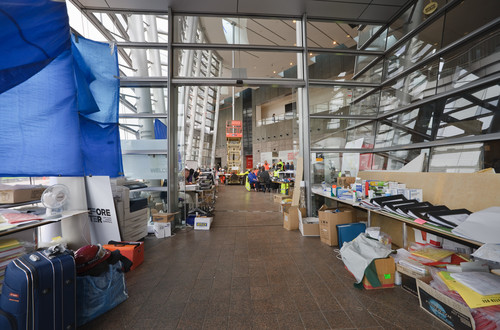B.
Uttër Drech at Christchurch Art Gallery
Behind the scenes
Bunker Notes Newsdesk, 25 August 2011: The biggest public art event in the country has been happening for months in Christchurch Art Gallery without anyone realising, organisers claimed today.
Twenty-Four Month Sculpture (South Seas Variation) is the work of Uttër Drech, who has claimed Christchurch Art Gallery and the Earthquake Recovery teams occupying it as a living, breathing artwork.

Uttër Drech at the Gallery (artist not pictured). Photo: John Collie
Uttër, 48, who famously refuses to be photographed, is no stranger to controversy. A conceptual artist described by re-flux.com as being like 'Damien Hirst without the sex, religion and talent – and we don't even think Hirst is very good', he generated headlines in Europe recently with Eurotrashcloud, his proposal to burn back issues of Artforum magazine near Frankfurt airport in an attempt to simulate the effects of the recent Mexican volcano and bring air traffic to a halt. Speaking to Artforum magazine, Uttër described the unrealised work as an 'investigation of global capital flows expressed through the medium of hot air'. Uttër's Christchurch work is an example of what is known in the art-world as 'relational art', which involves cooking or playing sport with a curator nearby.
Uttër, who was so moved by the plight of Christchurch people that he agreed to travel to the city economy class, devised his living sculpture after only a day and a half in the city. 'Research is crucial for me', he said from his Rangiora hotel room, 'and I've really enjoyed getting to grips with the intimate textures of this city, with its streets and buildings and other facilities.'
Uttër says he has called his work Twenty-Four Month Sculpture in reference to an event called Twenty-Four Hour Sculpture which occurred in New Zealand several years ago. 'I admire this twenty-four hour project', he said, 'except for its length'. Uttër's own project is projected to last for twenty-four months, which is how long some local commentators believe it will take until the Gallery building re-opens to the public. However, Uttër claims his project is like the earlier one in one crucial way – 'no actual audience members are seeing it. It lives in the realm of the idea, the proposal, the utopian speculation, the dream of a better world.' When asked 'better for whom?', Uttër responded with a quote from the philosopher Wittgenstein to the effect that what cannot be spoken of must be passed over in silence. He then asked us if we had an adapter so he could recharge his iPhone.
It is when elaborating the meanings of his enormous artwork that Uttër really comes into his own. 'It is a total work', the diminutive artist said while sweeping through the Gallery foyer in his floor-length 'Matrix'-style trenchcoat, 'a gesamtkunstwerke, an opera of the ordinary.' Uttër's attempts to use a scissor lift to command a better view of his work came to an end when a CERA official intervened, but he was able to turn his attention to a nearby 'still life' – a trestle table full of high-visibility vests, cans of spray paint and other Civil Defence equipment. 'Look at this', he said, picking up a yellow helmet. 'It is just a hat. But look at the gap inside it. The hat yearns, it longs. For a head – perhaps even a brain.'
Asked how he felt about being part of such an important art project at the Gallery, one of the Earthquake Recovery workers in the building replied: 'This place used to be a gallery?'
Thanks to the generosity of an Auckland patron, Uttër Drech will be travelling home Premium Economy.